|
Notan
Let's start with a good photo reference. I took this photo of my cat as part of a series for a competition painting I'm planning, so let's see how it turns out with a series of notans exploring several different possibilities for laying out the final version. Two or three of these pleased me enough that I may follow up on them and do this in artist grade oil pastels on Colourfix paper or Wallis.
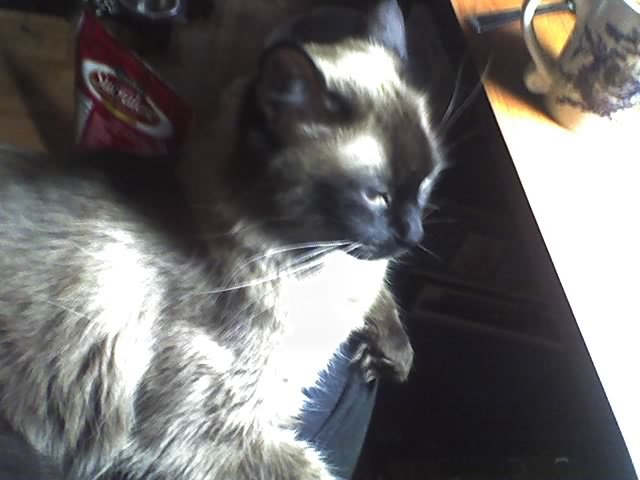
The photo isn't perfect, but it doesn't need to be. It's clear enough that I can draw from it, that's what counts. The light comes from above and to the right, it's cool light from my Daylight table lamp. It gives a good set of highlights on my cat's dark points, but the camera exaggerated how light his chest fur is. This is fine for what we're doing. To try this either with my photo or any photo of your own, you'll need a black pen, brush tip or felt tip, and one or two gray or mid-value pens. It can be distracting to use colors like red and yellow for your mid-values, so it's better to use grays or monochrome colors. You can also use a light blue and a dark blue with the same effect, since blue works very well for monochrome drawing. I chose to use Tombow brush pens. These are waterbased, have big self-wicking brush tips and are very responsive. They let me get fine details with the tips but fill large areas quickly by turning the point on its side or pressing harder. I've also used Pitt Artist Pens if I'm doing them smaller. Both of these products are available at Blick, Jerry's Artarama and most art stores, but you can also just use any type of markers. Even kid markers will work fine as long as you have a black and two grays or blues, one light and one dark.
Pure Black and White NotanSo let's begin. Here's the first notan I created, just using the black pen in an area sketched off on a larger sketchbook page. I marked up six areas to start so that I'd definitely do more than one version even if I liked what I got on the first one.
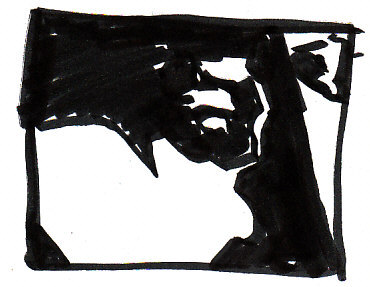
This one is the truest to the principle of notan. All of the dark areas are simplified into a single irregular black shape when they overlap, even if that leaves the edge between the figure and ground invisible as with Ari's dark ear against the dark background. This shows me the photo has a good composition to begin with. I could use this exactly as it is. One trick that may be very elegant, which I plan to try sometime using Colourfix primer on watercolor paper, is to take a simple notan like this, work out the outlines a lot more exactly and then sketch them on the paper. Then prime all the white areas with white and all the black with black precisely, so my darks are painted over black and my lights over white. This could strengthen the values of the entire painting and give an overall unity even when soft light colors do define the shape of his chest against the highlight on my pants leg. Try this at home, it only takes moments. If all you have to sketch in your notans is a ballpoint, then fill in the dark areas solid and leave the white ones blank and you're fine. For adding mid-values as I'm about to do on the later ones, you can hatch and crosshatch with a pen to get the same result -- a mid value tint on an area that doesn't have to exactly define anything about the subject. Nonetheless, it's clear in this little black on white notan exactly what the subject is and more or less his position. Let's see how it looks adding values in darker and lighter gray Tombow pens in the next one.
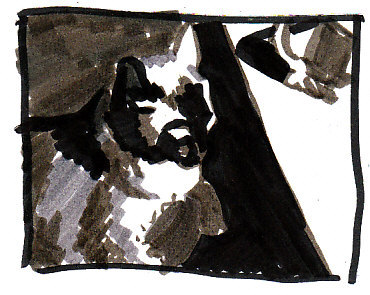
By accident I picked up a light cold gray with the dark warm gray, but that at least makes the lighter areas very easy to distinguish from the darker ones. This has nothing to do with color, it's everything about how light or dark any given space on the painting is. The cat's paw and my highlighted pants leg are closer to the same value than not, so they blur in together. The shadow of the cup is quite darker than the cup itself. The designs on the cup aren't important, but the overall tone of the cup and its shape matter. Incidentally, don't bother trying to be careful when sketching notans. The idea is to see what's going on rather than to render everything precisely. Feel free to scribble. I sketched off the borders without using a ruler in order to encourage myself to work fast and loose, just look at the photo and sketch what was light or dark in it as accurately as possible without worrying overmuch about detail or whether it's perfect. One benefit of doing this is that you wind up sketching the subject more than once. Each time I did one, I was more familiar with the actual shapes of the dark or light areas and got their irregularities more accurately. By the time I do the painting, I should be able to produce a good line sketch on a larger scale with all its proportions right. This looks good, this could be a good painting as it is. It's one of my candidates for what to paint from. But I still had six spaces to fill with examples and so I considered other compositions. What if I cropped it to a vertical layout?
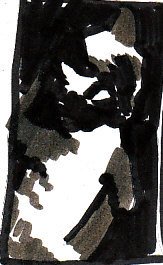
I liked the vertical layout, it's interesting, but I decided I wanted to see it a little bit wider with a little more space especially to the right, to balance it out better. This is the sort of design decision notans can help with. The more I worked with this series, the less I was paying attention to the subject and the more to just whether the dark space was an interesting shape compared to the light space. Every notan is like a yin-yang symbol. It's the interplay of light areas against dark ones in an abstract sense that makes a painting pop. You can paint as accurately as you like, carefully trace your reference photo and use every trick to put in every hair. One famous photorealist even duplicated a JPG artifact in a mural he created from a high resolution digital photo. But if the basic design doesn't look good in a thumbnail reduced to black and white or black, white and two mid-values, the painting is going to seem flat and something about it will be annoying or dull even to people who don't understand design and composition.
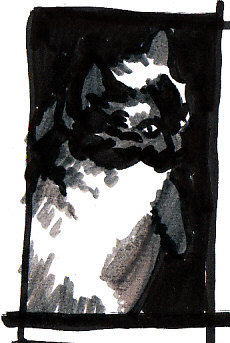
If I do use a vertical composition for this painting, this is the one I'll use. It's got a little more space to the right and the upside down L shape in darkest dark really makes the cat pop forward. I like the paw dangling, there's something sweet about the shape of his relaxed, dangling paw, so this one really emphasizes that. It's a good contender for a final version for my oil pastel painting. Both of the vertical formats got rid of the angled table beside him completely, which was something I liked. That angle is very dramatic in thumbnail, it's a sharp clean division and contrasts pleasantly with the curved organic shapes of the cat's head and body. But the cup at the upper right, interesting as it is, could be a distraction in a serious painting. If I gave it enough detail for it to make sense, it'd also draw attention away from the focal point -- the cat's head and eyes, secondarily the dangling paw. So I tried another notan, this time just eliminating the cup but keeping the table there at that dramatic angle.
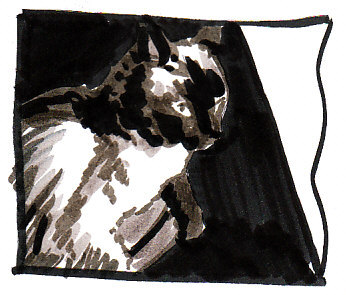
None of these took more than a minute or three to draw. I could check the way the composition looks without the cup directly againsnt my first and second notans. To my surprise, it didn't work as well without the cup as I thought it would. The white space is too intense over there, if I use this one I may have to add another object to break it up. Something simpler than the cup, maybe a catnip mouse or something related to the cat by theme. Finally, I decided I wanted to see how it'd look with a close crop just on his face for a good portrait painting. I love this cat, I love doing his portrait and the expression on his face is very sweet in most of this series of photos. He was purring and relaxed, idly watching me wave the phone camera around clicking it now and then and looking at the results. So here's the last notan -- a full face portrait, zooming in on the cat's face, losing the paw (which might be another distraction from his eyes as a focal point) and coffee cup and table.
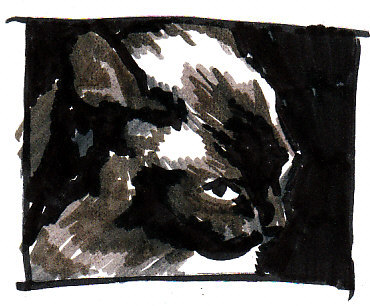
I created my crop by opening the photo in Gimp where I could enlarge it, then adjust the shape of the window on the screen to crop temporarily to what I wanted. I do this all the time, it's very convenient. When I want to see something in more detail, I zoom in, as I did to crop for the portrait notan. This is one of the good ones. I may wind up doing two paintings from this photo because I like both the second vertical format and the portrait format -- both of them discovered by creating notans with Tombow pens on paper in my sketchbook. But there's another way to get a very accurate notan using Gimp. If I was getting ready to grid the line drawing and use primer to paint black in the darks, white in the white and a mixed gray in the midtones, I would probably do something like this and then blow it up. Open the source image in Gimp. Do a Save As and add something to the file name, like "notan-1" so that you have a version separate from the original, colorful, detailed photo. Then on the image itself, look at the row of menu names. Select Color. Slide down to choose and click on Hue-Saturation. There are three slides in that dialog. Hue tints it greener to the right and purpler to the left. Lightness is self explanatory. Saturation, the bottom slide, is the one you want. Push it all the way to the left to create a grayscale version of your photo. Save it and then if you want to keep that as a detailed guide to exact values, do a Save As on the grayscale and call the next notan-2 or something. Again on the Color menu, go down to Brightness-Contrast. It has two slides. Ignore Brightness unless you need to adjust it to make the photo's image visible. Start clicking on the lower slide to the right, increasing Contrast. I raised Contrast to 70% on this version of my photo, which created a perfect black-and-gray Notan of the original image. E could easily crop this using the rectangular selection tool to create another image for the portrait or vertical notan, or just "crop" visually by enlarging and moving the sides of the viewing window. But if I want it as a printout, I'd do another Save As and then crop to what I chose.
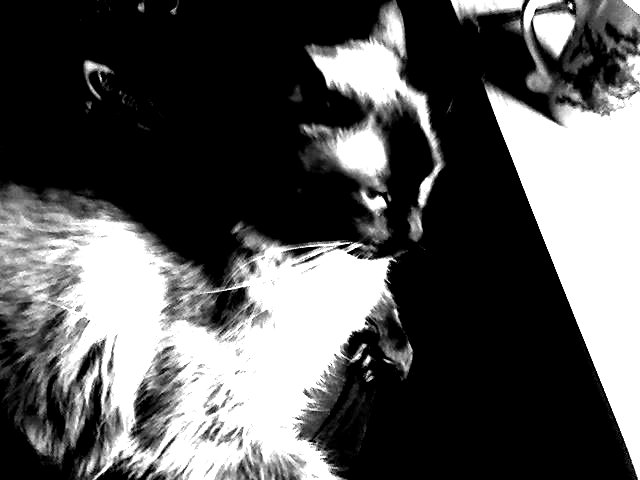
That gives me something I can carefully enlarge mechanically using the grid method or a pantograph or an opaque projector, if I want to be sure to follow my photo exactly in creating the line drawing to paint from. It eliminates distractions and shows the photo's composition as is, or with my crop. So feel free to download Gimp from either of those links, it's free and it does everything Photoshop can. Computers are a remarkable tool for artists, and the geeks at http://www.gimp.org have put it into the hands of even starving artists -- or those who'd rather spend their money on Senneliers than software. Even with these technological tricks though, the benefits of sketching notans by hands can't be emphasized enough. It's the process of looking at things to do them that helps change the way you see life. Value changes become a lot more obvious, and so do shapes even when they're made up of multiple objects. Shadows start to become as important as forms -- and it is shadow that makes forms three dimensional to read true in art. One last trick on supplies -- if you're doing them on sticky notes at the office, just use a pen for the black and a pencil for the grays. That's another easy way to get two or three distinct values on white or light backgrounds. Notans don't have to be perfect, large or detailed. Like thumbnailing, they are a guide to making design decisions and seeing the subject in terms of light and dark without favoring one over the other. That's where yin-yang thought comes into this. The white areas aren't better than the black areas. The black is defined by the white, the white is defined by the black, they are intimately interconnected parts of the same whole. Get them right in your final notan and your painting will shine!
|





